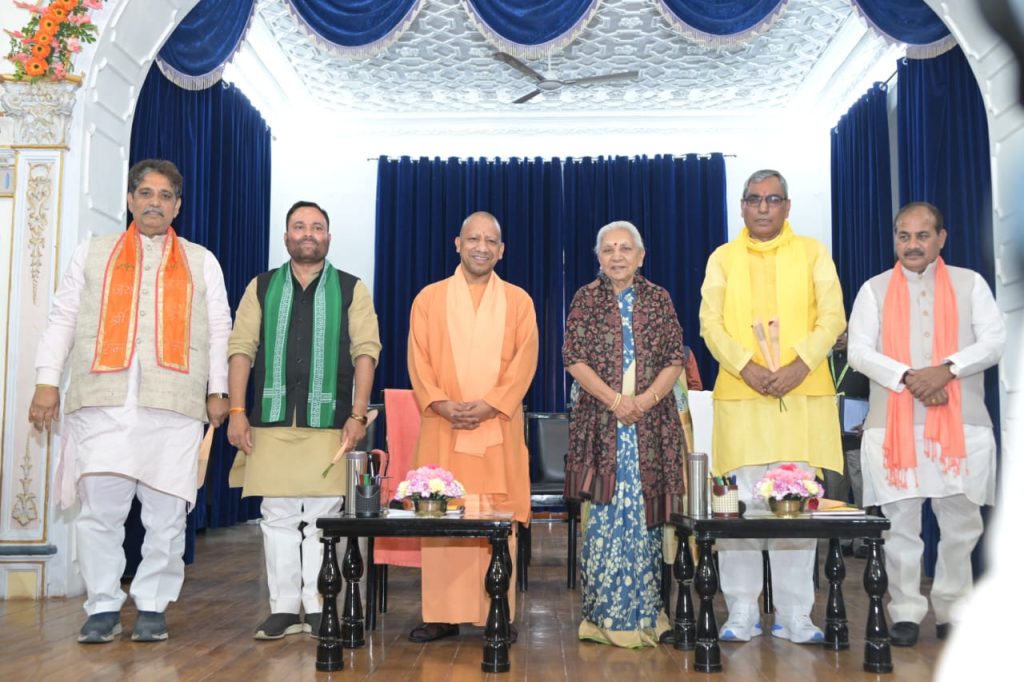Image Source: National Political Mirror
On Tuesday, Uttar Pradesh Chief Minister Yogi Adityanath expanded his Council of Ministers, welcoming four new ministers to the BJP-led coalition ahead of the upcoming Lok Sabha elections. This move included the inclusion of two allies, the Suheldev Bhartiya Samaj Party (SBSP) and the Rashtriya Lok Dal (RLD). Adityanath’s selection of new ministers aimed at striking a balance across caste and regional lines. SBSP chief Om Prakash Rajbhar, RLD’s Anil Kumar, and BJP’s Dara Singh Chauhan and Sunil Kumar Sharma were sworn in as ministers by Governor Anandiben Patel at the Raj Bhavan in the presence of Chief Minister Adityanath.
Om Prakash Rajbhar, representing the Zahoorabad assembly constituency of Ghazipur district, brings regional representation and political acumen to the Cabinet. Anil Kumar, an MLA from Purkazi (SC) in Muzaffarnagar, adds diversity and grassroots perspective. Sunil Kumar Sharma, BJP MLA from Sahibabad in Ghaziabad district, brings administrative experience and party loyalty. Dara Singh Chauhan, a member of the UP Legislative Council, offers legislative expertise and party coordination.
This Cabinet expansion marks a strategic move by Chief Minister Adityanath to broaden representation and strengthen governance in his second term, reflecting a mix of regional, caste, and party considerations in the selection process.
Table of Contents:
BJP leaving no stone ahead of Lok Sabha Elections
Image Source:PradaPhash
With the Lok Sabha elections approaching, the saffron party is ramping up its efforts to secure a substantial number of seats in Uttar Pradesh, a state of immense political significance often referred to as the gateway to Delhi. Recognizing Uttar Pradesh’s pivotal role in national politics, the BJP is sparing no effort to strengthen its presence and support base, knowing that success here could translate into national dominance.
The entry of Jayant Chaudhary’s Rashtriya Lok Dal (RLD) into the NDA alliance is particularly significant in Western Uttar Pradesh, where a sizable Jat voter population exists. The RLD is all set to fight in 2 seats from Baghpat and Bijnor as it finalises its seat-sharing pact with the BJP. This alliance could bolster the NDA’s prospects in the region, adding to its momentum as it aims for electoral success.
INDI Alliance in Uttar Pradesh
Image Source: India Today
With the Congress and Samajwadi Party finally sealing their alliance after a prolonged struggle, the Grand Old party is set to contest on 17 seats. Reports suggest that Priyanka Gandhi may contest from Raebareli, following her mother Sonia Gandhi’s decision to vacate the seat and move to the Rajya Sabha from Rajasthan. Additionally, Rahul Gandhi might contest from two seats, including Amethi, which he lost to Smriti Irani in 2019, and possibly Wayanad.
Rahul Gandhi’s Bharat Jyodo Nyay Yatra recently traversed Uttar Pradesh, during which he highlighted key issues such as unemployment and corruption. The journey aimed to connect with the people and address their concerns, emphasizing the need for social justice and economic equality. With its performance declining since 2014, the Congress Party’s main vote base in Uttar Pradesh traditionally includes a diverse coalition of supporters, including minorities such as Muslims and Dalits, as well as segments of the rural and urban poor.
However, the party has faced challenges in maintaining its traditional support base due to factors such as leadership dynamics, organizational weaknesses, and electoral strategies. To rejuvenate its standing, the Congress Party is focused on revitalizing its appeal among traditional support bases such as minorities and the rural and urban poor, along with forging connections with new constituencies. This involves tailored messaging, community outreach, and grassroots mobilization endeavors aimed at broadening its electoral base and revitalizing its political relevance.



